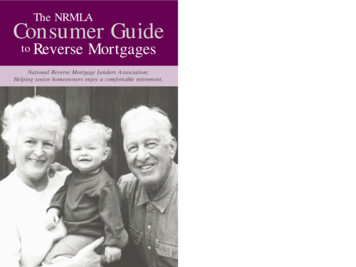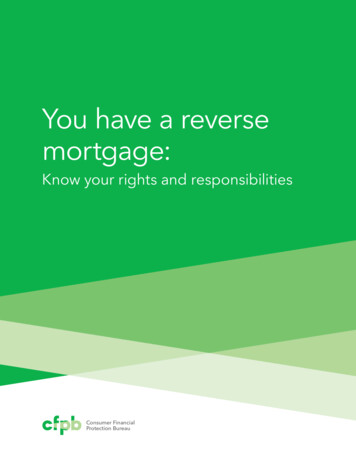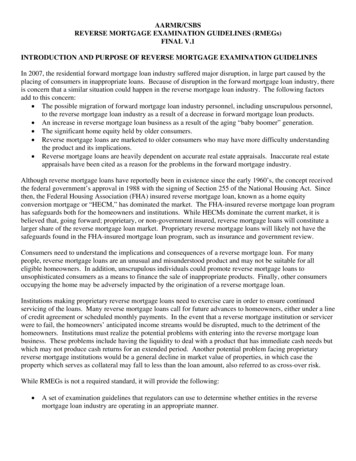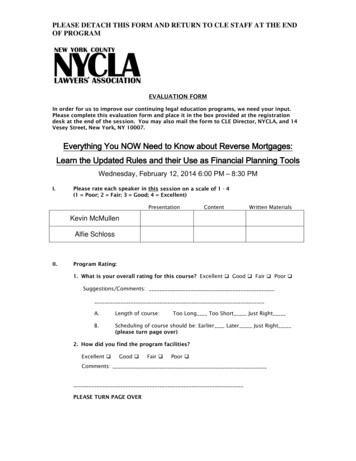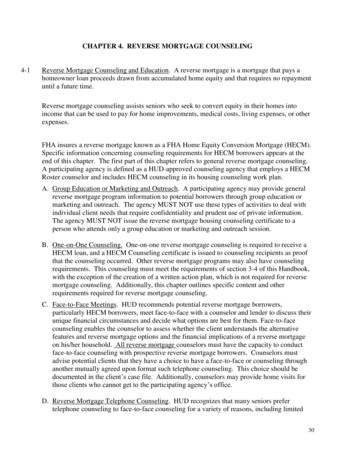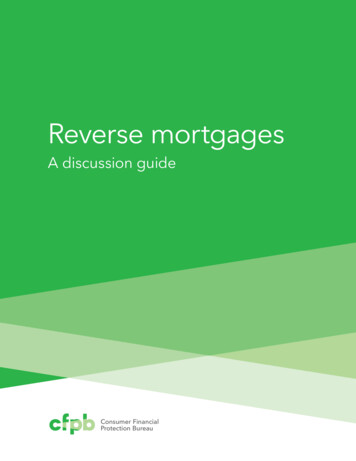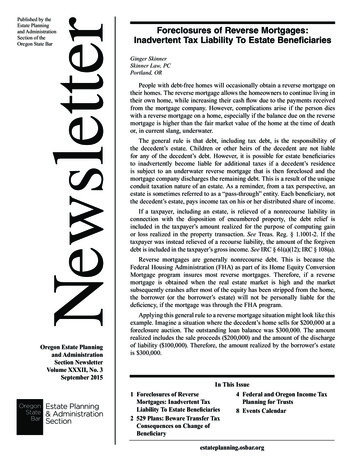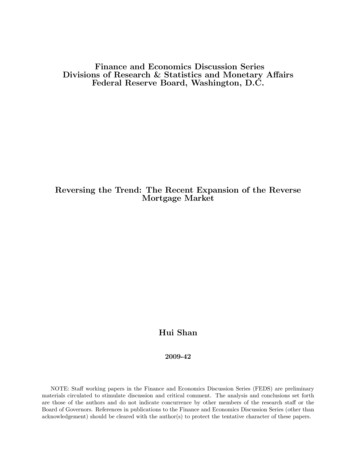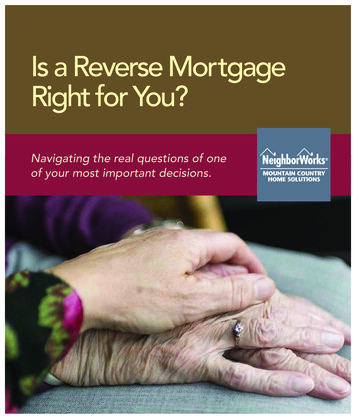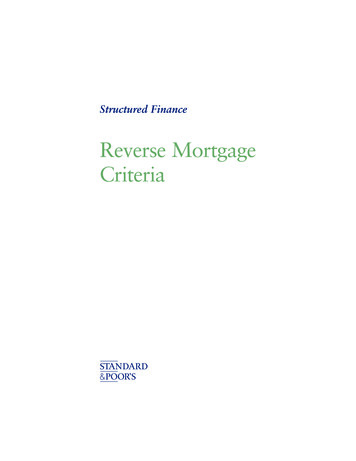
Transcription
Structured FinanceReverse MortgageCriteria
STANDARD & POOR’SPresident Leo C. O’NeillExecutive Vice PresidentsHendrik J. Kranenburg, Robert E. Maitner, Vickie A. TillmanSTANDARD & POOR’S RATINGS SERVICESChief Rating Officer Vickie A. TillmanExecutive Managing DirectorsEdward Z. Emmer, Corporate RatingsClifford M. Griep, Financial Institutions RatingsJoanne W. Rose, Structured Finance RatingsVladimir Stadnyk, Public Finance RatingsRoy N. Taub, Insurance RatingsPetrina R. Dawson, Senior Managing Director & General CounselRATINGS INFORMATION SERVICESManaging DirectorJay S. KilbergVice PresidentsAndrew Cursio, Product ManagementRobert Frump, Production & Electronic DistributionPaul Stanwick, EditorialDavid A. Collins, Director, Asia-PacificTherese Robinson, Director, EuropeSusanne Barkan, Product ManagerSara Burris, Director, Design, Production, & ManufacturingJean-Claude Bouis, Editor, Franchise ProductsDonald Shoultz, Editor, Policy & OperationsEditorialJennifer O’Brien, Managing EditorDoug French, Audrey Kennan, Donald Marleau (Tokyo), Cynthia Michelsen, Jackie Rodgers (London)Miriam Stickler, Lisa Tibbitts (Editorial Managers)Jennifer Bale, Maureen Cuddy (Copy Editors)Design & ProductionSandy Fong, Beth Russo, Michael V. Wizeman (Senior Managers)Elizabeth McCormack, Steve McLure (Senior Designers)Rosalia Bonanni, Barrie Cohn, Heidi Weinberg (Designers)Maura Gibbons (Junior Designer)John J. Hughes, Alicia E. Jones, Robin Tucker, Leonid Vilgorin (Managers)Christopher Givler, Dianne Henriques (Production Coordinators)Stan Kulp, Michelle McFarquhar, Michele Rashbaum (Senior Production Assistants)Subscription InformationHong Kong, (852) 2533-3535London, (44) 171-826-3510Melbourne, (61) 3-9631-2000New York (1) 212-438-7280Tokyo, (81) 3-3593-8700Web Sitewww.standardandpoors.com/ratingsPublished by Standard & Poor’s, a Division of The McGraw-Hill Companies, Inc. Executive offices: 1221 Avenue of the Americas, New York, N.Y. 10020. Editorial offices: 55 Water Street,New York, N.Y. 10041. Copyright 1999 by The McGraw-Hill Companies, Inc. All rights reserved. Officers of The McGraw-Hill Companies, Inc.: Joseph L. Dionne, Chairman; Harold W.McGraw, III, President and Chief Executive Officer; Kenneth M. Vittor, Executive Vice President and General Counsel; Frank Penglase, Senior Vice President, Treasury Operations.Information has been obtained by Standard & Poor’s from sources believed to be reliable. However, because of the possibility of human or mechanical error by our sources, Standard &Poor’s, or others, Standard & Poor’s does not guarantee the accuracy, adequacy, or completeness of any information and is not responsible for any errors or omissions or for the resultsobtained from the use of such information.
Reverse Mortgage CriteriaThe Rating Process forReverse Mortgage Transactions . . . . . . . . . . . . . . . . . . . . . . . . . . . . . 5Review of the Originator’s and Servicer’s Operations.Collateral, Legal, and Structural Analysis . . . . . . . . .Rating Committees . . . . . . . . . . . . . . . . . . . . . . . . .Rating Surveillance . . . . . . . . . . . . . . . . . . . . . . . . .5677Collateral Descriptions forReverse Mortgage Transactions . . . . . . . . . . . . . . . . . . . . . . . . . . . . . 9Issuer and Servicer Reviews . . . . . . . . . . . . . . . . . . . . . . . . . . . . . . . . 11Mortgage Servicing and Underwriting . . . . . .Servicer and Originator Eligibility. . . . . . . . .Originator and Servicer Review . . . . . . . . . .Loan Origination . . . . . . . . . . . . . . . . . . . . .Underwriting and Quality Control . . . . . . . .Secondary Marketing . . . . . . . . . . . . . . . . . .Loan Administration . . . . . . . . . . . . . . . . . .Operational Benchmarks . . . . . . . . . . . . . . .Servicer and Master Servicer Responsibilities.111112131315161618Credit Analysis of Reverse Mortgage Transactions. . . . . . . . . 23Appreciation . . . . . . . . . . . . . . . . . . . . . . . . . . . . . . . . . . . . . . . . . . . . . . . . . . . 23Repayment Rate. . . . . . . . . . . . . . . . . . . . . . . . . . . . . . . . . . . . . . . . . . . . . . . . . 24Interest Rate . . . . . . . . . . . . . . . . . . . . . . . . . . . . . . . . . . . . . . . . . . . . . . . . . . . 26Structural Considerations forReverse Mortgage Transactions . . . . . . . . . . . . . . . . . . . . . . . . . . . . 27Rating Pass-Throughs. . . . . . . . . . . . . . . . .Letters of Credit and Corporate GuaranteesSpread Account Criteria . . . . . . . . . . . . . . .Payment Structures. . . . . . . . . . . . . . . . . . .Standard & Poor’s Structured Finance. .Reverse Mortgage Criteria.272828291
Special Hazard. . . . . . . . . . . . . . . . . . . . . . . . . . . . . . . . . . . . . . . . . . . . . . . . . . 30Swap Criteria. . . . . . . . . . . . . . . . . . . . . . . . . . . . . . . . . . . . . . . . . . . . . . . . . . . 31Cashflow Analysis forReverse Mortgage TransactionsBase Assumptions .Bond Value . . . . . .Collateral Value . . .Data Requirements.Model Flow Chart .4141444747Legal Considerations . . . . . . . . . . . . . . . . . . . . . . . . . . . . . . . . . . . . . . . 49General Overview . . . . . . . . . . . . . . . . . . . . . . . . . . . . . . . . . . . . . . . . . . . . . . . 49Securitizations by Code Transferors . . . . . . . . . . . . . . . . . . . . . . . . . . . . . . . . . . 50Securitizations by SPE Transferors and Non-Code Transferors . . . . . . . . . . . . . . . 58Special-Purpose Entities . . . . . . . . . . . . . . . . . . . . . . . . . . . . . . . . . . . . . . . . . . . 68Collateral-Specific Criteria . . . . . . . . . . . . . . . . . . . . . . . . . . . . . . . . . . . . . . . . . 76Criteria Relating to Various Forms of Credit Enhancement . . . . . . . . . . . . . . . . . 78Criteria Related to Retention of Subordinated Interestsby Transferor in a True Sale . . . . . . . . . . . . . . . . . . . . . . . . . . . . . . . . . . . . . . . . 79Swap Opinion Criteria . . . . . . . . . . . . . . . . . . . . . . . . . . . . . . . . . . . . . . . . . . . . 81Interim Criteria for the Tenth Circuit Court of Appeals Eliminated . . . . . . . . . . . 83Criteria: Trustee, Servicer, Custodian, Eligible Deposit Accounts,and Eligible Investments . . . . . . . . . . . . . . . . . . . . . . . . . . . . . . . . . . . . . . . . . . . 84Select Specific Opinion Criteria/Language . . . . . . . . . . . . . . . . . . . . . . . . . . . . . . 92Representations and Warranties . . . . . . . . . . . . . . . . . . . . . . . . . . . . . . . . . . . . . 94Surveillance2. . . . . . . . . . . . . . . . . . . . . . . . . . . . . . . . . . . . . . . . . . . . . . . 101
Reverse Mortgage CriteriaAppendix AReverse Mortgage Glossary . . . . . . . . . . . . . . . . . . . . . . . . . . . . . . . . . . . . . . . 103Appendix BInformation Required for On-Site Review of Company . . . . . . . . . . . . . . . . . . . 109Appendix CSample Reports . . . . . . . . . . . . . . . . . . . . . . . . . . . . . . . . . . . . . . . . . . . . . . . . 121Appendix DReverse Mortgage Pool File Format . . . . . . . . . . . . . . . . . . . . . . . . . . . . . . . . . 125Standard & Poor’s Structured Finance Reverse Mortgage Criteria3
The Rating Processfor Reverse MortgageTransactionsThe rating process begins when a banker or issuer contacts Standard & Poor’sto discuss a proposal. For new issuers, initial conversations take place sixto eight weeks prior to the scheduled pricing of a transaction. Issuers withexisting reverse mortgage securitizations typically begin discussions three to fourweeks before a planned issuance. This beginning phase usually takes place through aconference call or brief meeting, where an overview of the transaction is presented.The purpose of this first stage is to identify any unusual or complicated operations,as well as structural, credit, or legal issues that may need to be ironed out before aformal rating process can begin. If no such complication exists, the rating processproceeds according to an agreed-upon time schedule. Issuers customarily sign a ratingcontract at this time.Review of the Originator’s and Servicer’s OperationsWhen the issuer decides to proceed, a complete analysis of the transaction begins.Rating analysts meet on-site with management of the originator or seller of thereceivables. This exercise enables analysts to expand their understanding of theissuer’s strategic and operational objectives. It also provides a more defined levelof familiarity with underwriting policies, contractual breach procedures, andoperational controls.Generally, the review includes: A financial and corporate overview of the originator and servicer as presented bysenior management; A discussion of the originator’s and servicer’s history in the reverse mortgagebusiness and strategic plan; andStandard & Poor’s Structured Finance Reverse Mortgage Criteria5
A meeting with senior management and key personnel from pertinent areas,such as underwriting, loan disposition, computer systems utilized by thecompany, internal audit, finance, and sales and marketing.In addition, a detailed discussion of the characteristics of the obligor base, therepayment pattern of the obligors, and the performance history of the assets, as wellas an examination of prior transactions, is typically undertaken. These discussionsare often complemented by walk-through tours of the originator and servicer.Analysts perform a review of all new issuers. For frequent issuers, analysts usuallyperform these reviews annually, or more frequently if circumstances have changed,for example, due to significant procedural or technological enhancements.It is important to note that the review does not include an audit. Instead, the ratingis based on the representations of the various parties to the transaction, includingthe issuer and its counsel, the investment banker and its counsel, and the issuer’saccountants. More details on the underwriting and servicer review criteria can befound in the “Issuer and Servicer Reviews” section. Collateral, Legal, and Structural AnalysisThe analysis focuses primarily on the legal, collateral, and structural characteristicsof the transaction. The legal criteria for structured finance ratings were developed inthe early 1980s for mortgage-backed securities (MBS). The fundamental tenet of thiscriteria is to isolate the assets from the credit risk of the seller.The collateral analysis involves an in-depth review of historical asset performance.Analysts collect and examine years of data on the performance variables that affecttransaction credit risk.The structural review involves an examination of the disclosure and contractuallybinding documents for the transaction. The criteria cover many aspects of the structure,from the method of conveyance of receivables to the trust, to the method of securitypayment and termination. The analysis also considers the payment allocation andwhat is being promised to securityholders.The prospectus for publicly rated transactions is prepared by the issuer’s counselbefore a transaction is priced. However, the underlying documentation determineswhether the structure will afford interest as promised and ultimate principal payments.The most important of these documents is the pooling and servicing agreement. Allnew issuers generally submit the first draft of the pooling and servicing agreement.This draft should be substantially complete, as significant subsequent changes tothe agreement may cause a delay in the rating of the transaction.6
The Rating Process for Reverse Mortgage TransactionsRating CommitteesA team of analysts is assigned to each transaction. After the team performs itsreview of the issuer’s operations and analyzes the collateral, a committee of appropriately trained and experienced analysts is assembled to determine whether the transaction has sufficient enhancement for the desired rating. Analysts ordinarily presentthe credit and structural aspects of a transaction to a rating committee before atransaction is priced.The transaction team is responsible for ensuring that all pertinent information ispresented to the rating committee. The committee presentation includes informationgathered from the review of the originator and servicer, collateral, cash flows, enhancement recommendations, and information on the legal and structural characteristicsof the transaction, which will be compiled into a confidential presentation. Once therating committee meets and makes its decision, the results will be conveyed to thebanker. A rating letter is issued at closing. For public ratings, a credit analysis isnormally disseminated.Rating SurveillanceAfter a rating is assigned, it is monitored and maintained by the surveillance process.The purpose of surveillance is to ensure that the rating continues to reflect theperformance and structure of the transaction as it was analyzed at transaction closing.Performance information is disclosed in a report prepared monthly by the servicer ofthe transaction. Before a transaction’s closing date, analysts review the data itemizedin the servicing report to ensure that all necessary information is included.The surveillance process encompasses monitoring issue performance and identifyingthose issues that should be considered for either an upgrade or a downgrade. Thesurveillance function also encompasses tracking the credit quality of all entities thatmay be supporting parties to the transaction, such as liquidity enhancers. Analystsreview performance data periodically during the course of the transaction and contactthe issuer and trustee if ratings change. For changes to public ratings, a press releaseis normally disseminated.Standard & Poor’s must be informed of any changes concerning the originalstructure of the transaction, including management, credit policy, system changes,or any change in the status of the original parties involved in the transaction.All information will be used as part of normal surveillance maintenance forthe transaction.Standard & Poor’s Structured Finance Reverse Mortgage Criteria7
Collateral Descriptionsfor Reverse MortgageTransactionsAreverse mortgage is a nonrecourse first lien mortgage loan, typically givento a borrower who is age 62 or older, that requires no repayment until thesale of the property. Each reverse mortgage is secured by a specific propertyand contains standard contractual mortgage terms, conditions, and default remedies.Types of reverse mortgages (RMs) made by lenders include: A series of periodic, typically monthly, loans that are made to borrowers; A lump sum payment that is made to the borrower on an interest accruing basis; A line of credit that is extended, subject to an agreed upon upper limit on thecumulated reverse mortgage to house value ratio; and Various combinations of the three types mentioned prior. By way of illustration,XYZ Mortgage Co. agrees to lend 60,000, at an interest rate of 9.5% perannum, which is 50% of the property value at the time the loan is closed.One of the positive attributes of a reverse mortgage, as compared to a conventionalhome mortgage, is that the homeowner is not required to repay any of the accumulatedinterest or principal until the loan is due. A reverse mortgage can be repaid at anytime but requires no repayments until the sale of the property. A sale occurs at theearlier of the death of the homeowner, a move, or lastly, demand for repaymentfollowing a contractual breach. In the meantime, the borrower continues to occupyand own the property assuming all responsibilities and benefits of ownership of theprincipal residence. Contractual breach occurs if the mortgagor fails to fulfill his orher obligation of paying property taxes, maintaining insurance, occupying the property,and keeping the home in good repair.Funds from a reverse mortgage are used to provide the borrower with cash or alife annuity. Use of reverse mortgage funds is varied. The major use of these fundsfor low income retirees is as an income supplement. Borrowers in the middle incomebracket typically use these funds for a major purchase or significant vacation. Asmall amount of borrowers use these funds for estate planning through tax planningand gift giving.Standard & Poor’s Structured Finance Reverse Mortgage Criteria9
Issuer and Servicer ReviewsMortgage Servicing and UnderwritingAt issuance of the securities, representations and warranties are made concerning the payment status of each asset and compliance with the characteristics for eligible collateral as prescribed by a particular issue. Generally, theservicer or originator is obligated within 90 days to repurchase assets showingdefects in documentation. Alternatively, other eligible collateral may be substitutedfor defective assets. Defects appearing thereafter also may cause assets to be repurchased or substituted. The master servicer or, if no master servicer is designated, theservicer, takes ultimate responsibility for overall servicing performance.Servicing functions include disbursing mortgagor payments, monitoring tax andinsurance payments, maintaining escrow accounts, investor reporting duties, andforeclosing and selling properties subsequent to a contractual breach of the borrower.Accurate servicing and accounting records should be maintained and certificates ofaudits forwarded to the trustee.Unless the servicer has an unsecured short-term debt rating of ‘A-1’ or higher,collections on pledged assets will be remitted immediately to the trustee or maintainedin fully insured custodial accounts. Additional liquidity support may be obviated ifthe servicer is rated in the highest short term rating category.No servicer may resign from servicing pledged assets unless these activities are nolonger legally permissible or unless an alternative servicer has been appointed. In theevent servicing is transferred, compensation to the successor is limited to the originalamount as specified in the legal documents governing the transaction.Servicer and Originator EligibilityQuality of underwriting and servicing of the mortgages underlying pass-throughcertificates is integral to credit quality and performance. Therefore, analysts willreview all elements of a company’s business related to the origination and servicingof reverse mortgages before determining whether that entity is eligible to participatein transactions. The review takes place regardless of whether or not the originatoror service, as a company, has a financial rating.Standard & Poor’s Structured Finance Reverse Mortgage Criteria11
When determining the eligibility of an originator and servicer, several key areasare analyzed. The following is listed according to procedural review rather thanimportance. First, the management team and organizational structure is reviewed todetermine the direction of future growth. Second, loan production functions includingproductions sources are reviewed. Third, to assess an originator’s loan portfolioquality, its underwriting and appraisal policies are evaluated. Guidelines that deviatesignificantly from the rating standards may result in higher credit enhancement levelsfor an issue since lax underwriting may increase risk of loss. For reverse mortgagesthis refers to the appraisal policies and practices of an originator. In extreme cases,Standard & Poor’s will decline to rate an issue if mortgage originators’ practicesare imprudent.Fourth, the company’s secondary marketing functions are reviewed for risk tolerance.Fifth, a servicer’s capabilities and portfolio are reviewed. Originators and servicersare typically approved seller/servicers for either Fannie Mae (FNMA), or the U.S.Department of Housing and Urban Development (HUD).Characteristics of a company’s servicing portfolio are good indicators of servicingquality. The total portfolio is analyzed for loan type, property type, average loan size,borrowers ages and genders, and geographic distribution. In addition, the servicer’sforeclosure and real estate owned (REO) procedures and performance are carefullyreviewed.Data processing capabilities are important in assessing the servicer’s abilities. Thesystem’s ability to service various loan types and its capacity to meet current andfuture servicing volume also are reviewed.Originator and Servicer ReviewAs previously mentioned, a review of the company is conducted and is summarized into five functional areas: management and organization, loan production,underwriting and quality control, secondary marketing, and loan administration.The emphasis of the review is placed on the underwriting and loan administrationareas since these areas have the greatest impact on the ultimate performance ofthe loans. An increase or reduction to credit enhancement levels may be assessedpursuant to this evaluation. The specific increase or reduction percentage is determinant upon evaluation of the level of risk the company adds or diminishes tothe transaction.Prior to the on-site review, a questionnaire is sent to the company for completion.This questionnaire includes operational policies, procedures, and performance results(see appendix B). The review begins by meeting with management to become familiarwith the company’s organizational structure, the experience of key managers, andthe company’s overall plan for growth, new products, new markets, and employee12
Issuer and Servicer Reviewstraining. Management should have a well defined business strategy, which has beensuccessfully executed. The company is evaluated, in part, on its orientation to operatingand financial risk and its reaction to market variables. Procedures for all areas shouldbe well documented, with all the necessary controls, licensing, and insurance coveragesin place.Loan OriginationIn analyzing an originator’s production capabilities, the volume of loans originatedand acquired for the past five years is reviewed. In addition to examining total volume,it is necessary to evaluate production categorized by property type, age, gender, maritalstatus, loan amount, geographic distribution, and loan to value ratio. This informationhelps determine the company’s level of experience with various loan products. Production also should be reported by loan type, (fixed- versus adjustable-rate mortgages)as well as by product type (line of credit, lump sum payment, monthly payments, ora combination of these types). This information gives further insight into the company’sexperience with various loan types. It also may illustrate the extent to which it hasoperated prudently in the past.The sources of production are also reviewed including loans originated versus loanspurchased, the percent from wholesale correspondents, and brokers, as well as thegeographical distribution of the production. Reviewing the source of production isnecessary for several reasons. A geographic distribution indicates the company’sfamiliarity with the laws of various states. Geographic dispersion aids in diversificationof the company’s production risk and servicing portfolio exposure.Similarly, if a large portion of its production has been acquired, the company’sapproval process for each correspondent and broker is carefully reviewed. The company must also track the performance of loans purchased from various correspondentsand brokers. All third party originators should be included in a quality controlreview at least annually. Also, an annual re-certification should be performed wherethe originators financial position, insurance coverages, and performance is reviewed.If loans from a particular correspondent or broker default frequently, then the companyshould do a closer screening of its loans, possibly modify its commitment with thecorrespondent or stop buying loans from that correspondent entirely.Underwriting and Quality ControlThe company’s underwriting guidelines and quality control procedures are carefullyevaluated. Underwriting, quality control, and loan production should have segregatedreporting lines. To ensure that underwriting guidelines are being adhered to, anindependent audit team of the company should reunderwrite at least 10% ofStandard & Poor’s Structured Finance Reverse Mortgage Criteria13
production or a statistical sampling having a 95% confidence level. Also includedin the quality control audit should be a reappraisal or field review performed onat least 10% of the file audit. The quality control audit reports and findings arecarefully reviewed.Standard & Poor’s also monitors underwriting guideline changes. The specificunderwriting guidelines used to originate the collateral should be disclosed in theprospectus. Underwriters’ track records should be monitored the same way ascorrespondents’ and brokers’ loan quality. Exception approval policies are reviewedas well as the frequency and type of exceptions being made. These exceptions shouldbe tracked by the company. Likewise, the suspension and declination rates perunderwriter and originator should be closely monitored. Lending authority limitsshould be in place based on experience and capability of the underwriters.When underwriting a reverse mortgage, the lender considers the age and gender ofthe borrower, the interest rate on the mortgage, and the home value. Lenders makereverse mortgages based on assumptions relating to these components. First, thelender estimates the borrowers repayment rate based on the expected remaining lifespan of the borrower and the lender’s move rate experience. Then a home valueappreciation rate is applied to the current value of the home to determine what theproperty will be worth upon repayment of the loan.Based on given interest rates, the lender then determines how much money willbe lent to the borrower. The higher the interest rate the lower the amount of fundsa lender can lend to a borrower, since the interest will accrue faster and may exceedthe home value prior to repayment. Therefore, the older the borrower, the higherthe original loan to value ratio due to the expected earlier repayment. The pointat which the principal outstanding together with accrued interest exceeds the homevalue is where the potential for a loss or point of diminished return occurs. Thispoint is known as the cross-over point (see “Credit Analysis”). Lenders make loansbased on loan characteristics so that repayment occurs prior to the cross-over point.The borrowers age must be substantiated by acceptable documentation and occupythe property as his or her principal residence. Acceptable forms of documentationinclude: birth certificate, driver’s license, passport, and certificate of naturalization.All lenders must maintain the name of a third party contact whom the lender cancontact if the borrower cannot be reached. Through the annual occupancy certification,the borrowers will be asked to confirm that this individual is still the appropriatecontact.The appraisal process is of particular importance when originating a reverse mortgage.Therefore, the appraiser approval process and monitoring will be reviewed thoroughly.The criteria for property valuations for all first lien reverse mortgage loans requiresa 1004 Uniform Residential Appraisal Report or a form 2055 with an interior andexterior inspection.14
Issuer and Servicer ReviewsAlternative forms of collateral valuations are presently being utilized in the residentialmortgage market. Usually the alternative forms of collateral valuation are lesscomprehensive and may or may not require an on-site inspection depending onother characteristics of the loan application. Loan to value restrictions are generallyused as offsetting factors for the increased risk of using an alternative valuationmethod of the subject property. Automated collateral systems and alternative collateralmethods must be evaluated prior to inclusion of those loans in transactions tobe rated.All borrowers must hold title to the entire property that secures the mortgageloan. Any outstanding liens against the property must have been paid in full atthe loan closing, and the title evidence must show the reverse mortgage is in firstlien position. Title insurance is required for each reverse mortgage. In addition, thetitle policy must make no exceptions for negative amortization resulting from thecapitalization of interest, compounded interest, the capitalization of the payments tothe borrower, lien priority for loan advances, or the lack of a stated mortgage term.The property must be covered by hazard insurance, including flood where applicable.The amount of coverage required must equal 100% of the replacement value of thehome. The policy should either include provisions for inflation adjustments or providefor claims to be settled on a replacement cost basis. In addition, all policies, musthave a mortgagee clause so that the servicer is notified of any nonpayment of theinsurance premium.Secondary MarketingImprudent marketing policies can quickly deteriorate a company’s financial strength.The five main areas within secondary marketing: pricing, pipeline management,trading and hedging, securitization, and document delivery are reviewed. The reviewcovers the procedures for setting prices, how pricing is derived, and once decidedupon, how prices are disseminated to branches and third party originators. Withinpipeline management, the tracking of rate l
for Reverse Mortgage Transactions A reverse mortgage is a nonrecourse first lien mortgage loan, typically given to a borrower who is age 62 or older, that requires no repayment until the sale of the property. Each reverse mortgage is secured by a specific property and contains standard contractual mortgage terms, conditions, and default remedies.
